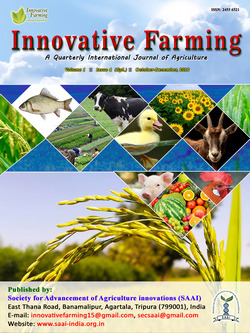
Response of Some Popular Cassava Varieties to Mosaic Virus and Two Major Sucking Pests Under Field Conditions in Tamil Nadu, India
N. Sakthivel
Regional Sericultural Research Station, Central Silk Board, Government of India, Salem – 636 017, Tamil Nadu, INDIA
DOI: NIL
Keywords: Cassava varieties, eri silkworm, mosaic disease, spiralling whitefly, papaya mealybug
Abstract
Surveys were undertaken in intensive cassava growing areas of Salem, Namakkal and Dharmapuri districts of Tamil Nadu adopting fixed plot survey method for five consecutive years (2010-15) to observe the response of some popular cassava varieties to cassava mosaic disease (CMD) and two important sucking pests namely spiralling whitefly (Aleurodicus dispersus Russell) and papaya mealybug (Paracoccus marginatus). Significant differences in the incidence of CMD were noticed among different varieties. Kunguma rose was found to have highest incidence of 95.68 % @ ten months after plantation (10 MAP) followed by H226 (91.20%), MVD1 (85.69%), H165 (47.51%) and CO(TP)4 (37.73%). Lowest incidence of 27.09 & 28.52 % was observed in CO2 and CO3 and thus exhibited tolerance to the disease. Infestation of spiralling whitefly started during the months of April-May i.e. @ 4-5 MAP and the population increased in relation to increase in plant age leading to severe incidence @ 10 MAP in October. Highest population per leaf (17.08) @ 10 MAP was recorded on MVD1 followed by H226 (15.37) and Kunguma Rose (13.98). The lowest population (8.12) was recorded on CO2 variety. The incidence of papaya mealybug was started @ 1 MAP and the severity in population build up increased with plant maturity. Highest population per leaf (97.95) was recorded on H226 followed by MVD1 (96.62), H165 (93.51), Kunguma Rose (92.60), CO3 (89.08), CO(TP)4 (85.42) and CO2 (81.15) @ 10 MAP. Based on the survey results it can be concluded that the cassava varieties resistant to CMD, spiralling whitefly and papaya mealybug should be preferred for cultivation to avoid the frequent damage and losses. Further, information generated under this study could help to pay more attention to set up timely management strategies.
Downloads
not found
Reference
Abraham, K., S.G. Nair and S.K. Naskar. 2000. Cassava breeding and varietal dissemination in India-Major achievements during the past 25-30 years. In: Proceedings of the 6th Regional cassava workshop. 21-25 February, 2000. International Centre for Tropical Agriculture, Ho Chi Minh City, Vietnam, pp. 174-184.
Alagianagalingam, M.N. and K. Ramakrishnan. 1966. Cassava mosaic in India. South Indian Horticulture, 14: 71-72.
Antony, B., V.S. Lisha, M.S. Palaniswami, V.S. Sugunan, T. Maheshkumar and T.J. Henneberry. 2006. Bemisia tabaci and Indian Cassava Mosaic Virus transmission. International Journal of Tropical Insect Science, 26(3): 176-182.
Banjo, A.D., A.T. Hassan, A.G.O. Dixon, I.J. Ekanayake and L.E.N. Jackal. 2001. Preliminary evaluation of resistance in cassava genotypes to spiralling whitefly. African Journal of Science and Technology, 1 (1-2): 194-196.
Dubey, G.S. and S.M. Prasad. 1994. Viral Disease of Tuber Crops, Advances in Horticulture, Vol.8-Tuber Crops. Eds: K.L. Chadha and G.G. Nair, Malhotra Publishing House, New Delhi, India, pp.419-422.
Edison, S. 2000. Present situation and future potential of cassava in India. In: Proceedings of the 6th Regional Cassava Workshop. 21-25 February, 2000. International Centre for Tropical Agriculture, Ho Chi Minh City, Vietnam, pp.61-70.
Edison, S. 2002. Plant protection problems in cassava in India. In: Proceedings of the 7th Regional Cassava Workshop. 28 October – 1 November, 2002. Bangkok, Thailand. pp. 264-270.
Edison, S., M. Anantharaman and T. Srinivas. 2006. Status of cassava in India an overall view. Technical Bulletin Series 46, Central Tuber Crops Research Institute (ICAR), Thiruvananthapuram, Kerala, India, pp. 84-87.
F.A.O. 2012. FAOSTAT, FAO Statistics Division, (accessed on 5th February, 2012, http://faostat.fao.org).
Hahn, S.K., E.R. Terry and K. Leuschner. 1980. Breeding cassava for resistance to cassava mosaic disease. Euphytica, 29: 673-683.
Malathi, V.G., N.G. Nair and P. Shantha. 1985. Cassava Mosaic Disease. Technical Bulletin Series No.5, Central Tuber Crops Research Institute, Thiruvananthapuram, Kerala, India. P.18.
Mandal, R.C., K.D. Singh and S.B. Maini. 1973. Effect of plant density, fertility level and shoot number on tuber yield and quality of tapioca. Indian Journal of Agronomy, 18: 498-503.
Mani, M. 2010. Origin, introduction, distribution and management of the invasive spiralling whitefly Aleurodicus dispersus Russell in India. Karnataka Journal of Agricultural Sciences, 23(1): 59-75.
Murugeswari, R., V. Balakrishnan and R. Vijayakumar, R. 2006. Studies to assess the suitable conservation method for tapioca leaves for effective utilization by ruminants. Livestock Research for Rural Development, 18(3): 1-11.
Neuenschwander, P. 1994. Spiralling whitefly, Aleurodicus dispersus Russel, a recent invader and new cassava pest. African Journal of Crop Sciences, 2(40): 419-421.
Palanisamy, M. S., K.S. Pillai, R.R. Nair and C. Mohandas. 1995. A new cassava pest in India. Cassava Newsletter, 19:6-7.
Rajinimala, N., R. Rabindran, S. Mohan and K. Sethuraman. 2011. Survey for the occurance of cassava mosaic disease in Tamil Nadu. Journal of Root Crops, 37(2):197-199.
Rajamma, P., T. Premkumar and C.A. Jayaprakash. 2001. Incidence of spiralling whitefly, Aleurodicus dispersus Russell (Homoptera: Aleyrodidae) in cassava. Journal of Root Crops, 27(2): 335-340.
Sakthivel, N., S.M.H. Qadri, R. Anbazhagan, T.S. Krishnamoorthy and S. Jayaraj. 2010. Cropping system of eri food plants for economically viable ericulture in Tamil Nadu. Asian Textile Journal, 19(4): 70-76.
Sakthivel, N. and S.M.H. Qadri. 2010. Incidence of papaya mealybug on tapioca in Tamil Nadu. Indian Silk, 1(5-6): 8-9.
Sakthivel, N. 2012. Studies on utilization of tapioca (Manihot Esculenta Crantz) for ericulture in Tamil Nadu, Ph.D., thesis submitted to Periyar University, Salem, Tamil Nadu, India.
Shanmugam, K. 2004. Cassava production technologies. In: Proceedings of the First National Symposium on Sago – SAGOINDIA 2004, 25th – 26th September 2004, Dept. of Chemistry, Sona College of Technology, Salem, India, pp.29-31.
Tanwar, R.K., P. Jeyakumar and S. Vennila. 2010. Papaya mealybug and its management strategies. Technical Bulletin 22, August 2010, National Center for Integrated Pest Management, ICAR, New Delhi, India, pp. 15-18.
